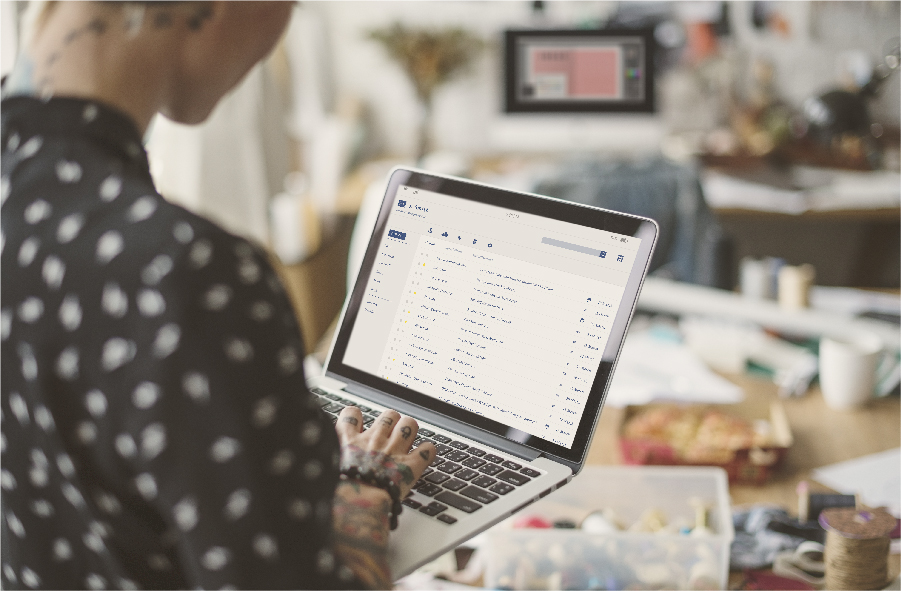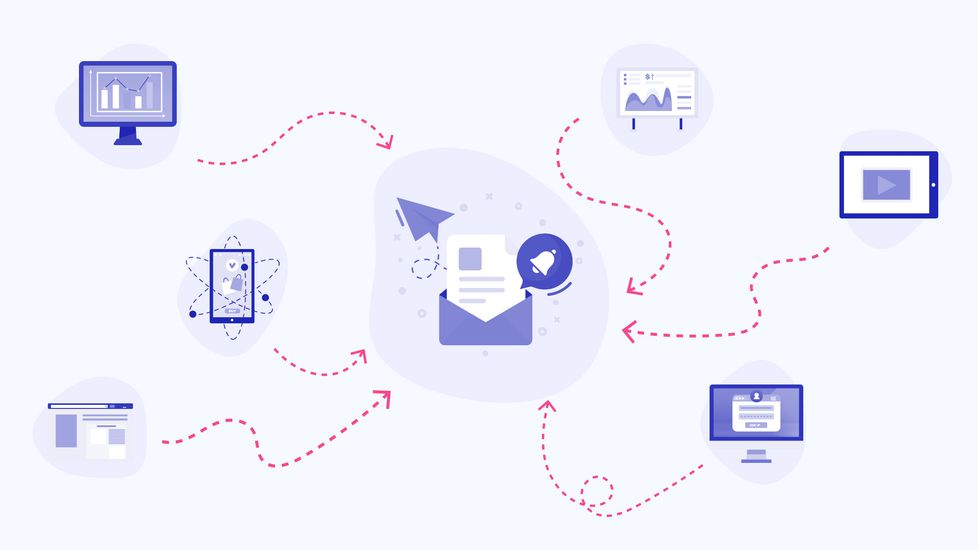The wheel of fate does not seem to stop. Every year or so a new trend will take the market by storm and force you to adapt in order to keep your clients in check. Today’s technology allows you to manage and interact with many people from the comfort of your seat and with just a few clicks. Today we at Global Database decided to share the main steps of newsletters’ evolution as well as the most efficient elements to use today to make yours effective and noticeable.
Newsletters: the start
But no matter how modern you believe your email and content marketing strategy to be, it can be traced back to ancient history and there were merchants damn good at it. The oldest acclaimed piece that is resting its decrepit page in the British Museum is a notice of reward in exchange for a runaway, inscribed on papyrus. Mails you ask? Ancient Egypt got that covered. 4,000 years ago there were no personal computers, however, couriers did just fine in delivering important decrees and, in time, so did pigeons.
Independent of the evolution of these marketing ways, history has yet again blessed us with a new communication method - penned newsletters. However, since most people were illiterate the handwritten reports could not relay any useful information. Moreover, the lack of a printing press meant that getting your hands on a newsletter was a rare occurrence, so we would have to wait until a person invents what was unbeknownst to them at that time.
New technology - new beginnings
It should come as no surprise that the discovery of the printing press made way for decades of Athena’s favour. Knowledge about recent events did not cost a fortune and could be afforded by many, as the dissemination of information goaded them to learn reading and writing. Books, flyers and brochures filled the shelves of printing press companies and, a bit later, the bicycles of delivery boys. One such 17th-century newsletter edition is a British circulation broadcasting current events and the far away curiosities from colonised places. In due time newsletters transformed, evolved, manifested themselves into forms that we could recognise today.

Early newsletters -> The Internet of Things -> Web-based newsletter marketing
Content marketing was not something widely recognised until slight usage into the coming of 2001, but some roots date back to the mid-1700s. Benjamin Franklin is one example as he used his printing business to give people information on what is today accessible at the touch of a finger - weather predictions, cooking recipes, funny or interesting trivia and so on. All these, actually, had an important underlying goal - to promote his printing business. Two centuries later countless bulletins provided the much-needed medium to exchange information on different topics.
Leaving aside how the ‘soap opera’ came to be and radios invading the porches of people, something else revolutionized the end of the 20th century - The Internet. Even before it was made publicly available after meticulous testing in university labs, you guessed it, an employee named Gary Thuerk managed to send the first world’s spam which generated $13 million in sales and a new task for the fiery researchers. Now while the intention was honourable, the execution was incomparable to what we have today. Nevertheless, as the email service became common, marketers of all kinds decided to jump in on the opportunity.
All types of respectable businesses use the email system to send electronic newsletters to the people who sign-up to receive them on their web-page. While some are constructed in a way to subtly pressure the reader into clicking links that would redirect them back to the business’s page, this is balanced by the many fully-fledged and ample publications. Just as the merchants of Babylon used clay tablets to appeal their products to new audiences, so do the electronic newsletters in alluring prospects to their side of the business. Not much changed, eh?
Time to spam newsletters
If it’s one thing you should learn from the history of newsletters is that starting from the handwritten pieces in ancient Rome it was always about delivering valuable information. That is the main characteristic that will be continued to be shared in all formats, even in the future. The sender becomes an authority and it’s on his honour to relay trustworthy material for people looking to be informed.

For quite a while, the historical essence of newsletters has been lost. Yet the current century’s regulations and laws brought it back, consequently handing the power to personally rule their inbox space to receivers.
How to make your newsletter truly effective?
As many other things in our lives, improving the effectiveness of your newsletters is a lot easier to say than to achieve. But don’t despair, it is not impossible, and we’ve drafted a list of what should and should not be done to improve the expected performance of your emails. Therefore, your B2B newsletters…
Should feature compelling subject lines
Of course, no one will open an email if it does not have an engaging title. We all have surely seen both weird and unattractive subjects, that made us skip the newsletter even from a sender whose emails we are usually eager to receive. In the same time, email titles should never lie about the content comprised, all you need is to find a balance between engaging yet formal enough that would fit the B2B environment you are part of. Of course, it is never simple. According to HubSpot, 30% of surveyed marketers apply audience segmentation tactics to improve email engagement, and so should you. A/B test the subjects, run them by your colleagues and make sure you capture all the feedback you get.
Should be responsive
Having your newsletters mobile-optimised is crucial nowadays. Single-column design has proven quite efficient for this particular task. As per HubSpot, mobile-friendly email is the 2nd most used tactic email marketers employ to improve their performance in 2020. Besides, according to the same source already two years ago about half of all emails were opened from a mobile device. Therefore, for your audience to read your newsletters instead of unsubscribing, make sure that your content and design are fit for mobile.

Should be engaging
Even though we are talking solely about B2B newsletters here, these should never be boring. Engaging newsletters are always fun in the way that would trigger positive emotions yet not transform into a charade. A great way to make your newsletter engaging is by telling a story. This year, according to HubSpot, promotional videos and brand storytelling are some of the most common video types created by marketers, and 87% of video marketers surveyed stated that video had increased traffic to their website. While keeping the formal business style, with or without videos, your emails should bring a positive note so that even the busiest CEO, when seeing the inbox notification, would think ‘yes, this is exactly what I need right now’.
Should be scannable
Living in a busy world, no matter how strong is your will to have your newsletters both opened and read, you should respect your audience’s precious time. Give them the choice to quickly scan the email and leave it if this time they don’t find anything particularly interesting. Even better, they might give it a glance now, notice something interesting and get back to it later. Keep in mind that, whatever the case is, the readers should not look up info they need, but see it right away. Moreover, they might not even know they need it before looking through your message.
There are newsletters that feature a table of contents at the top, yet we’d advise against it as, in our very personal opinion, it makes the email look way too long without starting to scroll through it. Think, that chances are high, that your newsletters may be briefly reviewed while waiting in the line in a coffee shop, or during the few minutes before the next meeting, and you should make the most out of these few moments of attention you receive.
Should deliver eye candy
It is no surprise that the B2B world walks hand in hand with visual content, and that it has always been better to explain insights via visuals rather than plain text or tables. Same is valid for newsletters. Delivering eye candy in the form of images, graphs and (why not?) small infographics will replace at least a few hundreds of words as well as improve the overall perception of the message you are willing to deliver. Besides, video has become the most commonly used format in content marketing, overtaking blogs and infographics, according to HubSpot. Alluring your readers with video is a great way to engage with them. Remember, that plain text is something many of us have to deal with all day every day. Therefore, you should use the chance to bring some delight to the eye of the beholder.
Should not be overloaded with elements
We’ve all seen newsletters trying so hard to grab attention that it obviously becomes too hard to actually understand the message. These emails try to embed all the possible and available elements that can be sent to an inbox. They have videos, images, buttons, graphs, huge CTAs written with weird fonts and, worst of all, leave no space whatsoever between them. Too much never works. Cluttered information and tasteless layout will still determine your B2B readers to unsubscribe, no matter how targeted your newsletters and how interesting your underlying message may be. Email aesthetics should never be omitted. According to HubSpot, over 20% of marketers surveyed stated that email design is improving their email engagement in 2020. Why would you want to miss out on that? Choose the most relevant elements and make a smart use of white space between them to make the newsletter easy to read.

Should be brief and simple
As we’ve already mentioned, it is likely that your subscribers use their few spare moments to check updates from senders just like yourself. Then as well they might be reading your email when taking a break between two tasks. Your message should not be a Shakespeare’s masterpiece, nor should the email as rich as the British Museum. So keep in mind, that delivering a concise, crystal clear and simple newsletter may be key to keeping them away from the unsubscribe button.
Should be recognisable
Regardless of the vertical you’re in, there should be something unique about your business. That feature that makes you unique is what also makes you recognisable - be it the brand of the company, the style of the company, the logo, bonus service or anything else that help the sender to stand out of the crowd - should be in or close to the header of the newsletter. Imagine how powerful it could be if, among a hundred other companies sending their newsletters on a regular basis, your readers would be able to name your company because they do remember it.
Should start with the theme
Especially suitable for companies that send newsletters every day, this recommendation implies including the main message or idea somewhere in the top 200-300 pixels. When the email is opened, something around that pixel area is what is seen first. Therefore, you might want to deliver your today’s core memo to help the reader understand right away whether it is worthy of his/her time. Considering that all your subscribers are generally interested in your field, they may not be that much excited to read 100% of your content. They will surely appreciate you respecting that. Help them sooner understand the treat of the day, hence help them to manage time to their liking.
Should have smart CTAs and/or buttons
UX is not about websites only. Newsletters should also be both pleasant to scan and clear to take the next steps. First of all, there should be one main action you would be willing your reader to perform. Therefore one of the used calls to action should have priority, should be obviously the most important, something that you can emphasize via a more compelling copy and/or some visual accent (e.g. brighter button, image). All the other CTAs would be secondary, to be followed in case the reader has time for them too.
A quite interesting touch to use from time to time relies in using a CTA button ‘Forward to a friend’ (colleague, partner). Shouldn’t be a surprise that it does work pretty well, helping spread the word as well as grow the list of subscribers.

Should have one common thread
Depending on your type of activity, your B2B newsletters may or may not have one common topic for all the subjects you comprise in the email. However, even if you are in the media industry, you just can’t send emails that would have one line about the universe, the next one about e-commerce, yet the next one - about kittens. Therefore the newsletter should have one common thread that would keep all the topics about one main subject, presented in a suitable way. For example, we at Global Database, as a B2B business directory providing comprehensive data and insights about companies all around the world, focus on data. We can share case studies and success stories of our beloved clients. We can provide some use cases for data directories by industry. We can make reports and analyses based on the information we have in our database, and many more. Yet all of our subjects will revolve around data, and that is what our newsletter subscribers know they will receive in their inbox.
Should not be spam
Nobody wants spam in their inbox, and there is not much more to add here. Successful newsletters should be at least 90% educational, and at most 10% promotional. The more value and the less advertising - the better. Your email should focus on the subscribers’, not your company. Therefore, keep delivering value instead of constantly offering your products or bragging about your achievements. Even the promotion part should not be a simple ad: tell a story, share a case study, help your audience relate to your clients and let them understand how your product served other businesses. Let the readers know that you are aware of their needs and show them how your product can help with that.
Should be clear and consistent
Your newsletters definitely have a certain goal. Regardless of what you are trying to achieve, the content of your newsletters should be consistent with your goal, and so should your CTAs. Your readers should understand pretty soon what you want them to do - whether it’s learning about your new feature or product, reading your new post (or any other new content you have on tap), check out your new offer or forward the email to someone who may gain something from the information you deliver. Make it clear to your subscribers what you would like them to do, and you will increase the chances that they will.
Should not give away all the information
Regardless of your main particular goal at the moment of sending, newsletters are always meant to remind your subscribers about your business. So it is very likely that you would still like the reader to land on your website. To achieve that goal, you should not include all the information in the email. First of all, chances are high that, if you do, then the newsletter will be way too long and probably will not even be fully scanned. Second, it wouldn’t generate the website traffic you’d expect. Therefore, you better unveil the key message in your email, yet leave the details behind. If interested, the reader will feel enticed to click through and explore the bait.
Should be smart
Before sending your next newsletter think about the ratio of visual and written copy you are willing to include. Yet keep in mind, that not all readers have images enabled. Therefore, if the biggest part of your email relies on images, and especially in the case when your visuals are actually CTAs, you should outsmart the layout and, if you can, add alt text to the images. Thusly you’ll stay assured that even if the reader won’t see the graphic part, the message will still get through.

Should be thoroughly tested before being sent
Nobody and nothing is perfect. Yet businesses should never quit improving and working on the products they deliver, and so shouldn’t marketing teams. Therefore, before sending newsletters, they should be thoroughly checked and tested. It is both frustrating and annoying when links don’t work, buttons lead to wrong landing pages, emails don’t display right either on mobile or desktop, videos show error messages instead of playing and so on. Before sending each newsletter to your audience, run them by some colleagues who will notify you if something is wrong and who can give you constructive yet non-biased feedback. It is much better if your colleagues notice a mistake than displaying a non-professional appearance to your B2B subscribers.
Should deliver an easy and clear option to unsubscribe
No matter how sad this may sound within the first few seconds, this is actually a huge benefit for you as a sender. First of all, you will be sure that the email you are sending is compliant with the regulations. Second, it will convey the subscribers the feel of freedom of choice - they might not want to unsubscribe, yet the ability to do so any time brings a lot of value. Third, keep in mind that if those who do not want to hear from you do unsubscribe, the ones that are left are your loyal and interested readers, hence you can be certain that you have one healthy list of subscribers. Last but not the least important, we’d advise against hiding the option to unsubscribe behind ‘smart’ copy or tiny fonts. Make sure that it is both clear and visible, and you will definitely rejoice at the benefits mentioned above.
Global Database adds to the effectiveness of your newsletters
It is no secret, that personalisation has become one of the main ways to stand out among a wide variety of B2B email marketing campaigns of hundreds of companies, which, be it your competitors or other businesses, are fighting for your audience’s inbox space. A B2B intelligence platform such as Global Database may help you stay effective with your newsletters by keeping you informed with up-to-the-minute events related to your subscribers. Monitoring their successes and challenges and surprising them with newsletters that would meet their immediate needs will be hard to ignore or forget.
Setting alarms or using an API to automate data enrichment in almost any tool you use to engage with your audience as well as letting them know that you are aware of their situation is just one of the ways you may improve the effectiveness of your newsletters.
